Our Products & Services
Getting Started
First Time Setup
Getting Started With Jobs
Getting Started with Accounts
Getting Started with Inventory
Getting Started with Ticketing
Setting Sonar up for Billing
Baseline Configuration
How To: Using Sonar's Customer Portal
User Specific Resources
Accounts
Account Groups: Overview & Example Use Cases
Account List View: Overview
Account Management View: Overview
Account Overview Customization
Account Statuses: Overview & Example Use Cases
Account Types: Overview & Example Use Cases
Anchor & Linked Serviceable Addresses: Overview and Best Practices
Archiving an Account: Overview
CPUC Fixed Broadband Deployment by Address
Child Accounts: Best Practices & How Tos
Creating a New Account
Direct Messages: Overview
Disconnecting an Account
Disconnection Reason Management: Overview
Exploring Task Groups
FCC Broadband Data Collection (BDC) Filings: How Sonar Can Help
FCC Data Exports: General Overview and Usage
Future Serviceable Addresses: Overview
Lead Intake Form Processing
Notes: Best Practices & Use Cases
Scheduled Events: Overview & Use Cases
Serviceable Addresses: Overview and Usage
Specify Account ID upon Creation
Tasks & Task Templates: Overview
Using Sonar's FCC Broadband Label Generation Tool
Billing
ACH Batching: Overview
Accounts in Vacation Mode
Avalara: Overview & Setup
Batch Payments & Deposit Slips: Overview
Billing Calculator
Billing Defaults
Billing Settings
Building Packages
Building a Data Service
Canadian ACH tool
Changing Service Pricing in Sonar: Best Practices
Considerations When Using Avalara with Voice Services
Creating Discounts for Services and Packages
Delinquency Billing Best Practices
Delinquency Exclusions: Overview and Use Cases
Dual Data Services: Overview
Email Invoice Batch: Overview
General Ledger Codes: Overview
General Transactions: Best Practices
How Sonar Prorates Billing
How to Take Bank Account Payments
How to: Adding a Service to an Account
Invoice Templates: Overview
Leveraging PayPal as a Payment Method in Sonar
Manual Transactions
Multi-Month Billing & Multi-Month Services
Print to Mail
Printed Invoice Batches: Overview
Services: Overview
Setting Up Payment Methods and Taking Payments
Setting up Bank Account & Credit Card Processors
Taxes Setup
Usage Based Billing Policies: Overview and Usage
Usage Based Billing Policy Free Periods: Overview and Usage
Using Tax Exemptions - How To
Communication
Communications: Call Logs Overview & Best Practices
Communications: Messages Overview
Email Variables & Conditions
Message Categories: Overview & Use Cases
Phone Number Types: Overview and Use Cases
Saved Messages: Overview
Setting up an Outbound Email Domain
Trigger Explanations
Triggered Messages: Setup
Using Outbound SMS
Using the Mass Message Tool
Companies
How to: Setting Up a Company in Sonar
Managing Multiple Companies in Sonar: Best Practices
Rebranding your Sonar Instance
Financial
Contract Templates
Invoice Attachment Use Cases & PDF Examples
Invoice Messages: Overview & Use Cases
Invoices in Sonar: Examples, Creation & Contents
Integrations
Atlas Digital CORE Integration
Calix Cloud Data Field Mappings
Calix SMx Integration: Overview
CrowdFiber Integration
External Marketing Providers
GPS Tracking Providers: Overview
GoCardless Integration: Overview & Setup
How to Connect Cambium to your Sonar Instance
How to Connect Preseem to your Sonar System
How to: Using Webhooks in Sonar
Integrating with Calix Cloud
RemoteWinBox - Integration with Sonar
Sonar Retain: AI-Powered Customer Retention & Quality Intelligence
The Sonar Field Tech App
Tower Coverage Integration: Overview
VETRO FiberMap V2 Integration: Overview
VETRO FiberMap V3 Integration: Overview
Webhooks in Sonar: Basic PHP Example
iCalendar Integration
Inventory
Inventory List View: Overview
Inventory Model Management: General Overview
Network Inventory: How-to & Usage Guide
Segmentable Inventory: How-to & Usage Guide
Setup of Inventory: Manufacturers, Categories, and Assignees
Tracking and Using Consumable Inventory
Jobs
Applying Task Templates to Jobs
Edit Job Options
Example Jobs & Templates
Geofences: Overview
Job Types: Best Practices
Jobs and Scheduling: Overview
Scheduling How-to: Creating and Booking a Job
Scheduling Week View: Overview
Setting Up Schedules General Overview
Mapping
Misc.
Combining Custom Fields & Task Templates for Information Storage
Custom Fields Overview & Use Cases
Custom Links: Overview
Task Templates Overview & Use Cases
Monitoring
Building Alerting Rotations
Building a Monitoring Template
Poller Troubleshooting
Pollers: General Overview, Deployment Strategy, Build Out & Setup
Networking
Adtran Mosaic Cloud Platform Integration: Overview
Assigning RADIUS Addresses
Assigning an IP Address Using Sonar's IPAM: How to
Automating IP Assignments, Data Rates, and Network Access in Sonar
Building Address Lists
Building RADIUS Groups
Building a Device Mapper
Cable Modem Provisioning
Controlling Customer Speeds with Sonar: General Overview
DHCP Delivery
Data Usage Available Methods
Finding your OIDs
FreeRADIUS 3: Build-Out & Integration
How Sonar Communicates - Egress IPs Explained
IP Assignments & Sonar
IPAM: Basic Setup
IPAM: Overview
LTE Integration
MikroTik as an Inline Device: Integration With Sonar
MikroTik: Controlling Access
MikroTik: Controlling Speeds
MikroTik: Setting Up a Sonar Controlled DHCP Server
Netflow On-Premise Integration: Setup and Overview
Network Dashboard: Overview
Network Sites: Management View Overview
PacketLogic: Integration With Sonar
Pulse, Polling, and PHP
RADIUS: Build-Out & Integration with Sonar
RADIUS: Building Reply Attributes
Setting Up CoA Proxy
Sonar Flow
Sonar IP Addressing
Using Multiple Network Devices in Sonar
Purchase Orders
Release Notes
Reporting
Enhanced Business Intelligence - Tips & Tricks for Advanced Users
How To Enhance Your Reporting With Custom Field Data
Report Licenses
Sonar's Business Intelligence: Overview
Understanding Sonar Reports
Using Sonar DataConnect to Connect BI Applications with Your Sonar Instance
Security
Application Firewall: General Overview and Best Practices
Auth0: Overview
Multi-Factor Authentication: Overview
Password Policy In Depth
Removing a Terminated Employee In Sonar
Role Creation using GraphiQL
User Role Creation & Best Practices
Users: Overview
Sonar Billing
sonarPay
sonarPay Canada Disbursements: Overview
sonarPay Chargebacks & Disputes: Overview
sonarPay Disbursements: Overview
sonarPay Monthly Statement: Overview
sonarPay Overview
sonarPay Reversals, Voids, & Refunds: Overview
sonarPay: Token Migration Process
System
A Deeper Dive into the New Sonar API
API Calls Using Third Party Applications: Personal Access Tokens
Browser Compatibility and Minimum Hardware Requirements for Sonar
Consuming the Sonar API
Controlling Your Landing Page: Personal Preferences
Customizing Your Customer Portal
Date/Time Picker: Overview
Dynamic Time Zones in Sonar
Filtering: Overview
Frequently Used Terms
Getting Your Data into Sonar
GraphQL Rate Limiting Overview
How To Use GraphiQL to Understand the Sonar API
How Your Data is Backed Up
How to Best Use Global Search
Interacting with Files via the API
Introducing the New Sidebar
Main Menu: Overview
Mutations in the Sonar API
Notification Preferences
REST API Wrappers for V1 Compatibility
SMS Notifications
Sonar's Rich Text Editor
System Settings: Overview
The New Sonar API
Troubleshooting the Customer Portal
Upgrading your Ubuntu OS - Customer Portal Upgrades
User Profile: Your Personal User Settings
Ticketing
Advanced Ticketing Features
Canned Replies Examples & Templates
Canned Reply Categories
Exploring Ticket Groups
How Sonar Manages Spam Tickets
How to Integrate Inbound Mailboxes with Slack
Inbound Mailboxes Example Build
Ticket Category Families & Ticket Categories: Overview
Ticket Resolution Reasons: Overview
Ticketing: Overview
Using Parent Tickets
Voice
API Changes for Voice Billing
Best Practices to Remain CPNI Compliant
Billing Voice Services in Sonar
Deploying Voice Services in Sonar
Working With the Sonar Team & Additional Resources
Sonar's Security Practices & Certifications
Sonar and General Data Protection Regulation (GDPR)
Sonar's Security Strategies
Technical Security Overview
Best Practices for Fast Tracking a Support Request
Feedback Portal / Suggest a Feature
Learning with Sonar: Tools and Resources
New Client Training Overview
Sonar Casts Table of Contents
Submitting Bugs vs. Feature Requests
The Sonar Community Forum
The Sonar Status Page
Third Party Customer Support Referrals
Table of Contents
- All Categories
- Jobs
- Scheduling Week View: Overview
Scheduling Week View: Overview
 Updated
by Mitchell Ivany
Updated
by Mitchell Ivany
Read Time: 5 mins
Scheduling jobs in your instance will often require a startling amount of foresight. The Weekly View helps you plan ahead by displaying jobs for the entire week, making it easier to manage job availability whether you're handling one or hundreds of appointments.
To access this page, navigate to the main menu, click on “Scheduling,” and then select “Week View” in the submenu.
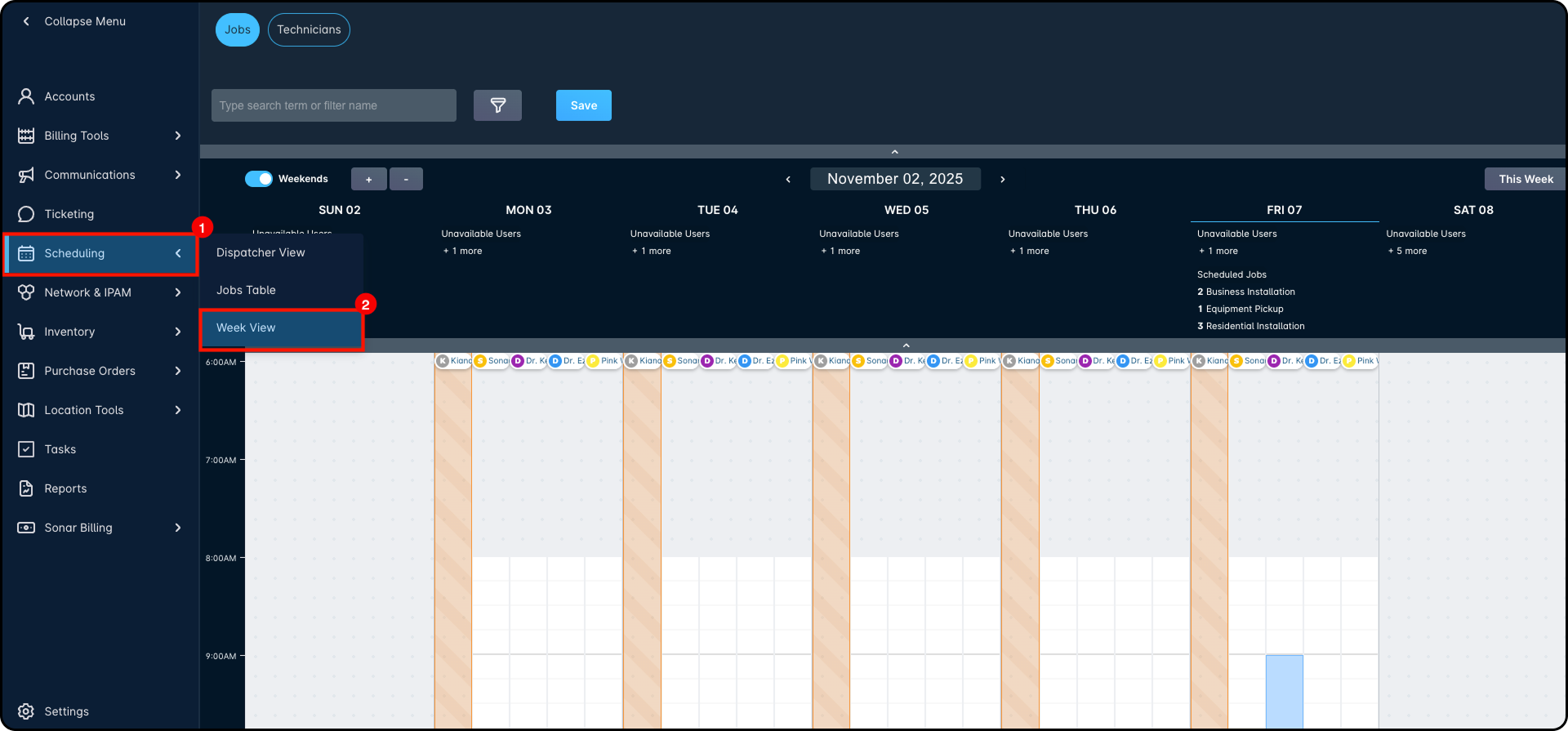
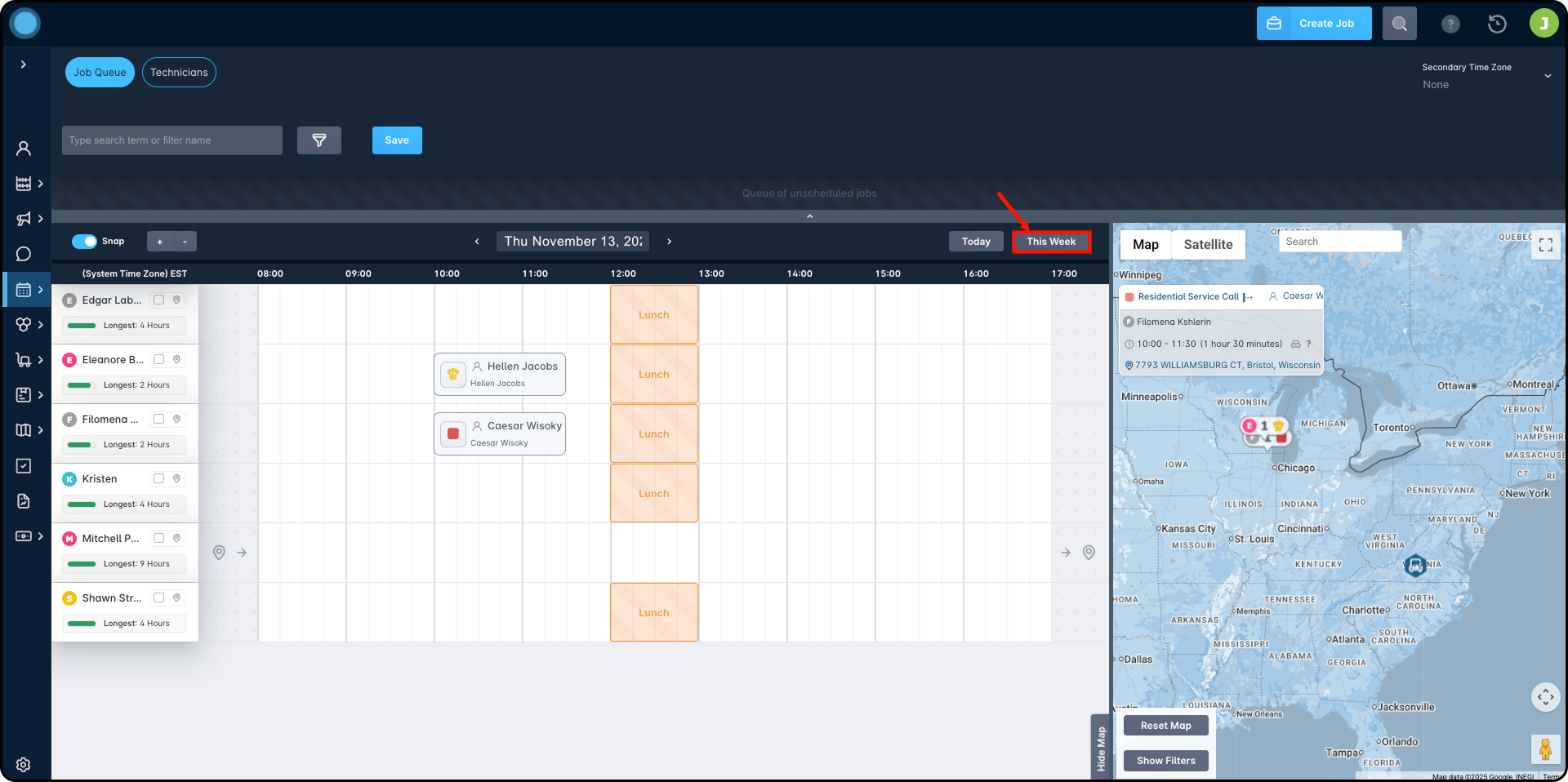
What is the Week View
The Week View is part of the Scheduling module. It shows all technicians along with their jobs, drive times, blockers, and time off for a selected week. It's mainly used to check availability quickly, not for detailed scheduling or booking new jobs. Although it shows a lot of information, it’s easy to read and understand.

- The Job/Technician toggle allows you to switch between the available filtering panels, which will affect the filter list.
- The Filter list allows you to search the calendar or apply predefined filters, based on the selected filter toggle.
- The Weekends toggle allows you to control whether Sunday and Saturday will be displayed on the calendar. If your organization doesn't schedule jobs over the weekend, this toggle can be disabled, and the calendar will only show the 5 weekdays.
- The Zoom In/Out buttons allow you to modify the scope of the calendar. Rather than zooming in to a particular section, the magnification expands the size of each time block.
- The Week selector allows you to choose which date range will be shown in the calendar section. When you select a date, the corresponding week will be displayed.
- The This Week button will take you to the current week, and display those dates on the calendar.
- The Weekly Summary section will list
- Any unavailable technicians, at the top of each day.
- The total number of scheduled jobs in a day.
- The Total number of each job type in a day.If there are too many unique job types to list, hovering over the “+X more” listing will provide the total of all hidden types
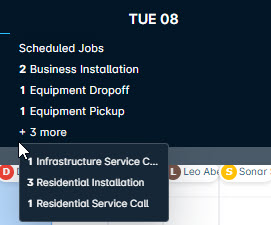
- The current day, reflected by the blue line underneath the date
- The Current Time slider provides a visual reference for the current time while you're in the Week view.
- The Weekly Calendar view contains a visual representation of all your jobs in any given week. This calendar has several functions:
- Each row will list your technicians based on their daily schedule availability. A single row will show 12 technicians before you need to scroll horizontally to see more.
- Hovering over a job in the calendar will display a pop-up, showing information about the job.
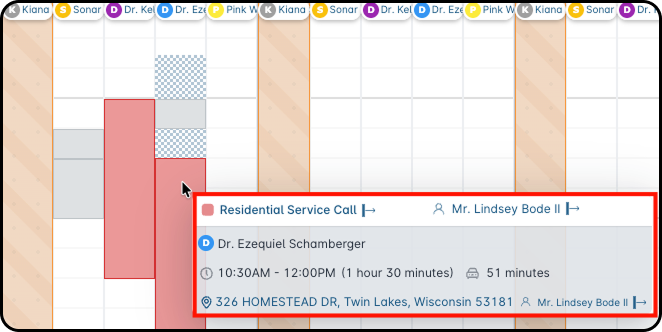
- This section also shows a full 24 hours. When zoomed out as far as possible, you'll be able to see entire 12-hour sections at a time.

Filtering in the Week View
The filtering for the Week View, much like the Dispatcher View, takes place across 2 different subsections – Job and Technicians.
Jobs Filters
These filters are used to narrow the overall view to specific jobs or job types, showing only those filtered results in the weekly calendar.
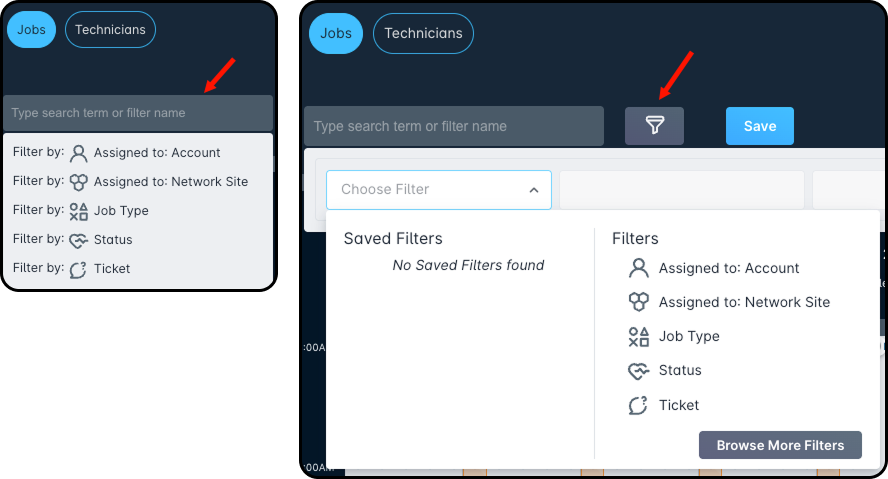
You have two available options when it comes to using filters. You can use the Search field, which will provide you quick access to default filters, or you can click the Filter icon, which will open all saved and default filters and allows for more in depth filtering.
- Assigned to: Account; which will show only jobs assigned to a specific account for the current selected week.
- Assigned to: Network Site; which will show only jobs assigned to a specific network site for the current selected week.
- Job Type; which will show only jobs of the selected type on the calendar.
- Status; which will only show jobs for the status which is chosen for the curret selected week.
- Ticket; which will show jobs that have the selected ticket assigned to them.
Technician Filters
These filters allow you to narrow your week view to show technicians who only meet specific criteria. Whether you're using the search bar or the filter icon, you'll be able to gain insight on specific technicians, and their workloads.
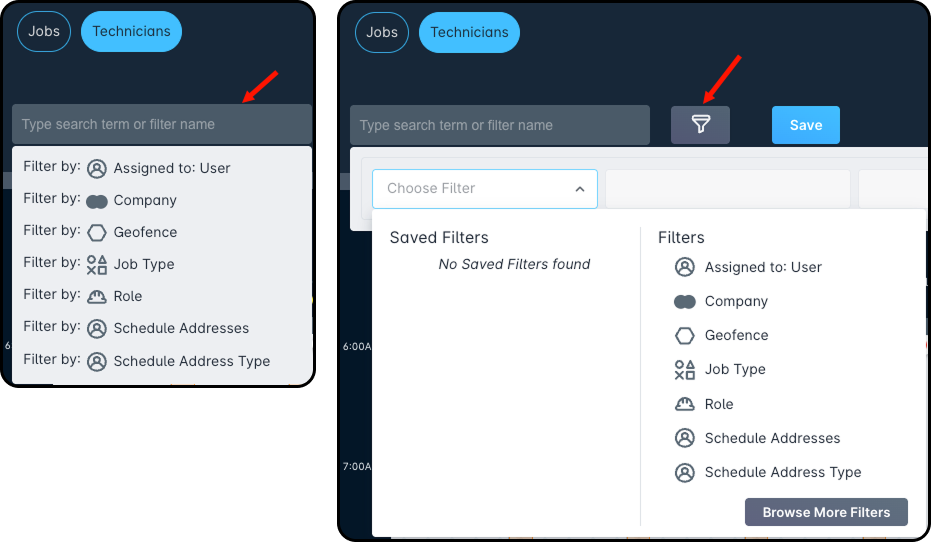
- Assigned to: User; which will filter the technicians by the user selected.
- Company; which will filter the technicians list based on which company (or companies) they're restricted to.This filter touches on the Companies section of the Job Type configuration, defined under Settings → Scheduling → Job Types.
- Geofence; which will show technicians based on the Geofences they've been assigned to.This filter touches on the Geofences section of the Job Type configuration, defined under Settings → Scheduling → Job Types.
- Job Type; which filters the technicians based on who is qualified to work the specific job type.
- Role; which filters the technician list based on their user role, defined in Settings → Security → Roles.
- Schedule Addresses; which filters the scheduled address in which you are searching.
- Schedule Address Type; which filters whether it is Both the start and end point, The ending point of the day, or The starting point of the day for the technician.
